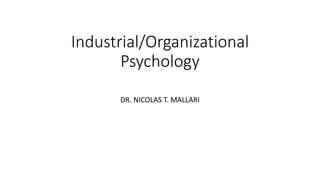
Industrial-Psychology.pptx
- 2. What is IO Psychology • is the application of psychological principles and theories to the workplace. • the attitudes and behaviors of employees and employers; interpersonal relationships at work; the structure of organizations and organizational policies; the complex processes of motivation and leadership; both individual and organizational performance; the context, culture, and climate of organizations; and the match between people and jobs.
- 3. • For example, principles of learning are used to develop training programs and incentive plans, principles of social psychology are used to form work groups and understand employee conflict, and principles of motivation and emotion are used to motivate and satisfy employees. • Thus, it makes sense that people who are happy with and productive at their jobs will lead more fulfilling lives than people unhappy with their jobs. If a person is unhappy at work for hours a day, the residual effects of this unhappiness will affect the quality of that person’s family and leisure life as well.
- 4. • Traditionally, industrial psychology and organizational psychology have been distinguished from each other based on their respective content areas. Industrial psychology(sometimes called personnel psychology, which shouldn’t be confused with personal or personality psychology) has long been associated with job analysis, training, selection, and performance measurement/appraisal. • Whereas organizational psychology deals with motivation, work attitudes, and leadership, as well as the structure, culture, and processes of organizations.
- 5. IO PSYCHOLOGISTS IN THE WORKPLACE Sample Job Titles Director of personnel Vice president of personnel Manager of human resources Organizational development specialist Personnel psychologist Senior consultant Compensation analyst Project manager Senior scientist Management consultant Research scientist Behavioral Sample of Companies with Tradition of Employing I/O Psychologists British Petroleum United Airlines Frito-Lay IBM Xerox AT&T Johnson & Johnson Goodyear Tire & Rubber Ford Motor Company Dow Chemical S.C. Johnson Wax Wells Fargo
- 6. Conducting Research in IO Psychology • Ideas, Hypotheses, and Theories • Hypothesis—an educated prediction about the answer to a question. • Theories are used to provide a model for understanding human thoughts, emotions, and behaviors
- 7. Laboratory versus Field Research Laboratory research. Experiments that are conducted in the laboratory setting. Disadvantage: external validity and generalizability Field Research. • has a problem opposite to that of laboratory research. What field research obviously gains in external validity it loses in control of extraneous variables that are not of interest to the researcher (internal validity).
- 8. The Experiment • the experimental method is the most powerful of all research methods because it is the only one that can determine cause- and- ef fect relationships. Thus, if it is important to know whether one variable produces or causes another variable to change, then the experiment is the only method that should be used. • Examples, the effect of incentive on job performance. Does illumination affect productivity? Can music improve concentration?
- 9. The Independent and Dependent Variables 1. Independent variable. Is a variable intentionally manipulated by the experimenter. 2. Dependent variable. Is considered to be the measured variable. Examples: Feedback improves retention Music enhances productivity Supervisory style affects motivation
- 10. Extraneous variables and Confounding 1. Extraneous variables indicate variables that are not the focus in the experiment but may contaminate the experiment if they are properly controlled. 2. Confounding variable indicates the value of extraneous variable changes systematically across the treatment conditions.
- 11. Types of Experimental Designs 1. Two-randomized-groups design 2. Two-matched-groups design 3. Repeated treatments design 4. More-than-two-randomized groups design 5. More-than-one-independent variable design
- 12. Quasi-experiments • Quasi-experiments are often used to evaluate the results of a new program implemented by an organization. For example, an organization that had instituted a child-care center wanted to see whether the center had any effect on employee absenteeism. To find the answer, the organization compared absenteeism levels from the year before the center was introduced with the absenteeism levels for the year following the implementation; the organization found that both absenteeism and turnover had decreased.
- 13. Archival Research • Archival research involves using previously collected dataor records to answer a research question. For example, if we want to know what distinguishes good workers from poor workers, we could look in the personnel files to see whether the backgrounds of good workers have common characteristics not shared by poor workers. • Or, if we want to see if people on the night shift had more turnover than people on the day shift, we could get information on shift and turnover from the company records
- 14. Survey • Another method of conducting research is to ask people their opinion on some topic. Surveys might ask employees about their attitudes toward the organization, HR directors about their opinions regarding the best recruitment method, or managers about the success of their child-care centers. • Surveys can be conducted by mail, personal interviews, phone, fax, email, Internet, or magazines. The method chosen depends on such factors as sample size, budget, amount of time available to conduct the study, and need for a representative sample.
- 15. Correlation method • Correlation coefficients (r) are used as the effect size when researchers are interested in the relationship between two variables, and the majority of studies use correlation as their statistical test. Examples include studies looking at the relationship between personality and job performance, integrity test scores and employee theft, and the relationship between job satisfaction and performance
- 16. Statistical Analysis 1. Descriptive Statistics. These are used to describe the basic features of the data in a study. They provide simple summaries about the sample and the measures. Together with simple graphics analysis, they form the basis of virtually every quantitative analysis of data. 2. Inferential statistics takes data from a sample and makes inferences about the larger population from which the sample was drawn.